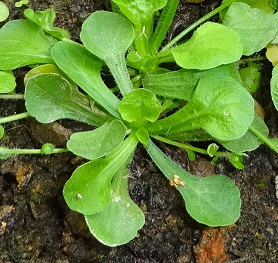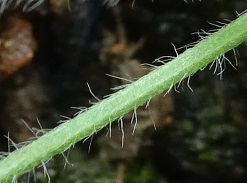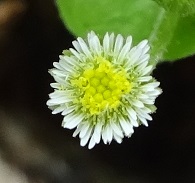| Home | Nature Weekly Index |
6 March 2016 | Daisy of Azores | Bellis azorica |
Note: The name of this plant should be Erigeron bellioides. Please read the update at the end of the post.

 I first discovered this plant in January this year and had shared it in
a post on 24 January. Back then, after some extensive search, I still had
no clue what plant it was except for its family Asteraceae. The first plant
that I dug up and planted in the pot did not do well. However, the subsequent ones did very well. On 14 February, I
finally got to see its full bloom flower; an outer layer of white ray flowers with inner yellow disk flowers. The full
bloom flower head is about 3 millimetres in diameter. Armed with this new information on the flower, I started to search
for Asteraceae with white ray flowers. I landed on the common Bellis perennis (Lawn Daisy). Its overall size was
too big to fit the plant that I had found though its leaves shape look similar. I began to look at other Bellies
species which led me to Bellis azorica. The pictures in the Internet fit relatively well to the plant that I now
grew in the pot.
I first discovered this plant in January this year and had shared it in
a post on 24 January. Back then, after some extensive search, I still had
no clue what plant it was except for its family Asteraceae. The first plant
that I dug up and planted in the pot did not do well. However, the subsequent ones did very well. On 14 February, I
finally got to see its full bloom flower; an outer layer of white ray flowers with inner yellow disk flowers. The full
bloom flower head is about 3 millimetres in diameter. Armed with this new information on the flower, I started to search
for Asteraceae with white ray flowers. I landed on the common Bellis perennis (Lawn Daisy). Its overall size was
too big to fit the plant that I had found though its leaves shape look similar. I began to look at other Bellies
species which led me to Bellis azorica. The pictures in the Internet fit relatively well to the plant that I now
grew in the pot.

 Information on Bellis azorica is scarce. It has been the subject of
a Portuguese postage stamp. Its pictures are available on the
Azorean Biodiversity Portal
that document the flora and fauna on the islands of Azores. Azores is an autonomous regions of Portugal and consists of
9 volcanic islands in the North Atlantic Ocean. According to
this Portuguese language blog, the plant
was found on the island of Flores, which in Portuguese means "flowers". Flores is one of the islands of Azores. The plant
is indicated to be rare and endangered in the Azorean endemic flora.
Information on Bellis azorica is scarce. It has been the subject of
a Portuguese postage stamp. Its pictures are available on the
Azorean Biodiversity Portal
that document the flora and fauna on the islands of Azores. Azores is an autonomous regions of Portugal and consists of
9 volcanic islands in the North Atlantic Ocean. According to
this Portuguese language blog, the plant
was found on the island of Flores, which in Portuguese means "flowers". Flores is one of the islands of Azores. The plant
is indicated to be rare and endangered in the Azorean endemic flora.
If my identification is correct, this would be the first Bellis species that was naturalized here. The holes in the turf pavers on the carpark ground is not an easy environment. Besides the frequent trampling by the wheels, it is exposed to full sunlight most of the time. The soil can be very dry after a few days without rainfall. It is rather unusual for a small European daisy species to survive and thrive in such conditions.
Update: 12 February 2017
By chance, I found the picture of this plant in a Taiwanese wildflower pictorial guide book with the name Erigeron bellioides in February 2017. Further check verified its identity. Though I did not get it right earlier, I did learn that another daisy by the name of Bellis azorica looked very similar to Erigeron bellioides.